|
Preserving the Memory
The Unknown American Holocaust Memorializations
By Jerry Klinger
“Grandpa,
what are you reading?” my young grandson asked.
“I am reading the obituary of
a Holocaust Survivor I had known.”
“Grandpa, if he is a
Survivor, why is he dead?”
William
Rabinowitz
”Remembrance is the Secret of Redemption.”
Baal Shem Tov
We all have curious
curiosities about our personalities. Mine, fortunately not being a
Cohen, is an esoteric form of historic tourism. I am a volunteer
photographer for Findagrave.com. Findagrave is an online site that
preserves images of the gravesites of over 70 million people.
Thousands of biographies of famous people and their final resting
places are preserved and digitally accessible at their website. I
have contributed hundreds of images and written numerous famous
biographies, including that of Theodor Herzl. For computer bound
historical tourists who want to touch a distant part of history,
Findagrave is an incredible resource.
Being a volunteer
photographer permits me to help other people, both Jewish and
Non-Tribal. Requests are sent to volunteer photographers, like me,
asking if we can find the resting place of a loved one or a distant
family member interred in a cemetery near where we live. The location
of the family member is frequently only vaguely known. If we can
locate a gravesite for a family, we are asked to photograph it and
enter the picture in the family memorial online page. It is an
interesting and enriching experience to help Christians and Jews
“reunite” with their families. It is also a living study
into history and culture. A friend once described cemeteries as
“outdoor museums.”
I happen to spend the winter of
the Jewish migration season in the warmer climes of Florida. A
request came in to photograph a few gravesites at Palm Beach Memorial
Gardens in Lantana, Fl. I took up my trusty camera and went in
search of the resting places of three Christians.
While looking for
the Christian resting places, I discovered a Jewish world that is
largely unknown, forgotten and beyond obscure. I discovered, or
perhaps it was intended that I discover, a major opportunity to be of
service to the Jewish people, to the Holocaust Survivor community and
to the Holocaust Survivors who have passed. What I discovered was an
obligation to the unknowns of the Holocaust and the effort to
remember them, that no one will admit is being forgotten.
Everyone thinks it
is a great idea, Rabbis, lay people, academics, 2nd
Generation Holocaust memorial groups. Everyone thinks it surely was
already done. Everyone is “wow” what a right thing to do.
No one has ever done it. No one was doing it.
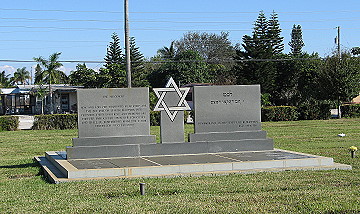
Palm Beach Memorial
Gardens is a non-sectarian cemetery alongside of the superhighway,
super busy Rt. 95 connecting Miami and points north. I have driven
by it many times but never had a reason to stop there until the
Findagrave email request to help a family came in. The cemetery is
divided into sections, including a consecrated one for Jews. The
local Chabad Rabbi has said the Jewish cemetery section is Kosher.
All the gravesites
are identified by flat stone grave markers three inches below the
thick green matt of the cemetery field. It makes finding anyone very
difficult. The Jewish section is no different from the Christian.
But it was different. There is a large stone memorial divided by a
prominent white colored Star of David in the middle. Naturally, it
drew my attention. I wandered over.
The memorial is two
carved rectangular, gray, hard polished, granite sections. The
wording on one side of the two gray polished granite sections is
simple and short, a quote from the Baal Shem Tov,
”Remembrance
is the Secret of Redemption.”
The left side is carved with a
much longer text:
“The
Holocaust”
“Now and
forever enshrined in memory are the six million Jewish martyrs
who perished. Their
suffering and heroism are forever emblazoned upon
our conscience and
shall be remembered from Dor L’Dor Generation to Generation.”
It is a striking, dramatic
memorial with crypts around the base where Holocaust Survivors sleep
until the end of time.
The Monument’s
words are strong. Similar words have been written in many places and
solemnly spoken at many a Holocaust Yom Ha’Shoah service. The
reality of Yom Ha’Shoah commemorations is different. The
suffering and heroism is fading from the conscience as the generation
of the Shoah passes. The Dor L’Dor remembrances are thin and
getting smaller at every service. Children are a rare sight. The
Rabbis have failed or declined to institute a special day of
religious observance for the Holocaust. Not a single mandated and
universally accepted Holocaust specific prayer has been added to
Jewish liturgy. The observance date for Yom Ha’Shoah is
controversial and not agreed upon in the Jewish world.
In Israel, Yom
Ha’Shoah is formally called Yom HaZikaron la Shoah ve- la
G’vurah: “Holocaust and Heroism Remembrance Day”.
Colloquially it is called Yom Ha’Shoah. It was inaugurated in
1953, anchored by a law signed by the Prime Minister of Israel, David
Ben-Gurion and the President of Israel Yitzhak Ben–Zvi. It is
held on the 27th of Nisan (April/May), unless the 27th would be
adjacent to the Sabbath, in which case the date is shifted by a day.
There were bitter debates in the Knesset in 1953 about Yom Ha’Shoah.
Many objected to the ceremonial recognition of Jewish weakness and
passive wholesale slaughter. They wanted to honor the heroic
resistance to the Holocaust and the rebirth of the modern State of
Israel as the shining example of Never Again.
At noon, in Israel, sirens sound
for Yom Ha’Shoah. Cars stop in mid street. Passengers get out
and stand in silence. With every year, fewer and fewer people stop by
the side of their cars for the moment of silence. They hurry on to
make the light. All acknowledge the Holocaust but they also
acknowledge their own personal, present concerns – a son, a
father, a cousin killed fighting to protect Israel, or perhaps a
terror attack. The Holocaust was a long time ago to them. It was a
Holocaust to someone else.

Photo by Kamran Saraf-Wikipedia
Miami has an
incredibly powerful Holocaust Memorial, an arm reaching imploringly
to Heaven in a plaintive appeal to God. The arm is covered with
figures of humanity in terrible suffering and torment. The Holocaust
Memorial is world famous. It has been written up, photographed
thousands of times and featured in many Holocaust centered stories.
Web searches for Florida and Holocaust Memorials are almost
exclusively directed to the Miami Holocaust Memorial site. The
Holocaust Memorial, in Palm Beach Memorial Gardens, is not one of the
search results.
I wondered. What
other Holocaust Memorials exist that no one knows about? Where my
parents are buried is an early Holocaust Memorial – a thin
stone pillar about five feet high with a stone eternal flame on top.
The word Zachor – Remember- is carved on one side. The
Memorial is obscured by overgrown arbor vitae bushes. Dedicated in
1949, the memorial contains the names of thousands who perished in
the Holocaust. No one knows it is there except for the few that
visit the row where their loved ones and my parents rest.
For the next week, I visited
Jewish cemeteries in South Florida, synagogues and local communities
in search of Holocaust Memorials. I searched online and in
libraries. The question became an answer. Where were the Holocaust
Memorials in the U.S. State with the second highest concentration of
Holocaust Survivors in the county? Did they not want to remember or
did they remember and no one knew?
I always called
ahead to the synagogues I was going to visit and asked if they had a
Holocaust Memorial. The question caught them off guard. The person
answering the phone usually did not know if they had a memorial even
when they did have one. Almost everyone had to ask someone else, did
they have a memorial?
Sometimes they
would say that they had a single memorial. When I arrived, I found
three. Many synagogues did have Holocaust Memorials of some sort.
What was surprising, and certainly not expected, was that a
significant number of synagogues did not. The general assumption that
all Jews memorialized the Holocaust is probably wrong.

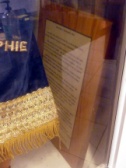
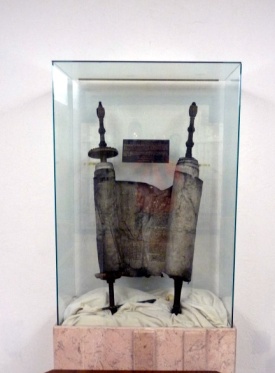
A few synagogues
have Czech Holocaust Memorial Torahs rescued from the Shoah. The
Torahs were displayed by some synagogues in prominent locations and
in others in wall cases that were not so prominent. Some synagogues
had Memorial plaques and wall art. One synagogue’s Holocaust
Memorials had a large dusty plastic shrub blocking the view of the
Memorial.
One synagogue had a
Holocaust memorial garden. They asked their non-Jewish custodian to
show me where it was. He took me behind the building to an alleyway.
The Memorial was hidden by high bushes. I doubted if even the
membership knew it was there. The Holocaust Memorial garden was a
simple thing, a few stones with the names of some of the
concentration camps and a bench. It had been created just seven
years earlier and seemed to be forgotten now. The only recent
visitors to the Memorial were the local Florida lizards and the
Hispanic grounds men who very poorly maintained the grass.
A local Rabbi
candidly shared with me,”when I first came here sixteen years
ago, we had a Holocaust Memorial plaque on a wall in the synagogue.
The building was renovated. We moved the plaque to an outside
Holocaust Garden. Then a hurricane hit. The garden was destroyed and
the plaque was ripped from the Garden wall. It was lost. We do not
have a Holocaust Memorial today. And, I do not know of any in this
part of the county.”
Memorials are not
the only memory being lost. A distressed Holocaust Survivor living
in Philadelphia shared with me his synagogue’s changing
attitude. The membership in the synagogue had created a Holocaust
Research Library of over 600 volumes. Every Yom Hashoah a display of
Holocaust artifacts and historical photographs were brought out into
the synagogue lobby. He told me that the library is curtained off
now, away from general access. The space is used as a bride’s
changing room. The Holocaust artifacts and historical photographs
were no longer permitted in the general synagogue. It was felt that
it might be too traumatic for the children. He did not know where to
go to preserve the library and their artifacts anymore.
There are an
unknown number of Holocaust Memorials in the United States today –
no one knows where they are. They have never been catalogued and
photographically archived. Some memorials are cemetery memorials,
some are rescued Holocaust Torahs, synagogue plaques, memorial
boards, free standing Memorials indoors and outdoors, stained glass
windows, gardens, interpretive art works, research centers,
libraries, web sites, self published biographies, University
Holocaust Studies chairs, major city or state sponsored Holocaust
Memorials, Museums etc.
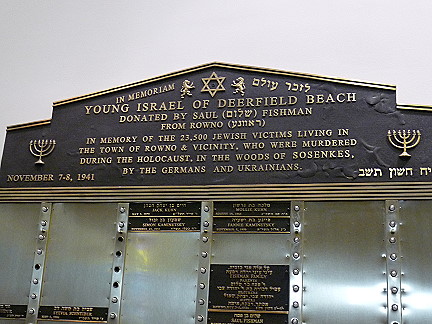
“In memory of the 23,500
Jewish victims living in the town of Rowno and vicinity, who were
murdered during the Holocaust in the woods of Sosenkes, by the
Germans and Ukrainians, Nov. 7-8, 1941,”
The early ones are
quite different from later ones in form and purpose. The methods, the
types, the purposes of Holocaust Memorializations have changed over
time. Memorialization has gone from very specific places and even
individual names to generalized, existential interpretations of what
the Holocaust means and its lessons for today.
American
Memorializations of the Holocaust were first begun by the Shoah
refugees. Most were erected by Survivor Associations and Survivor
City Mutual Aide Societies. They erected simple, carved Memorial
stones and placed them in Jewish cemeteries. They wanted to create
Memorials for those of their families and communities without a piece
of soil to say they ever existed. The refugees were not concerned
with forgiveness or any larger, deeper existential meaning to the
Shoah that later American and culturally homogenized Jews would seek
to interpret. Some of the Survivor Community Memorials wanted God to
take revenge, to seek justice. All wanted memory and peace for the
souls of the victims.

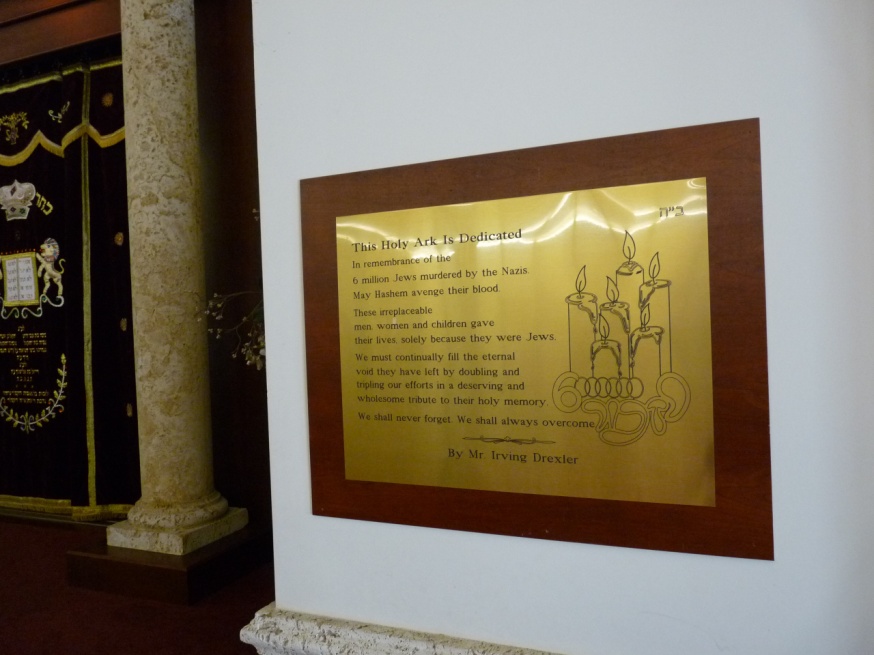
“Murdered
in the Holocaust”
“May God Avenge their Blood”
There were no
niceties in the early Holocaust Cemetery Memorials. They were blunt
and horrifically graphic in few words they had carved in their
stones.
“In
memorium… for the many sainted martyrs of our hometown Grybow,
Galicia who were brutally slaughtered by the German barbarians.
Three hundred and sixty of these are resting in one common grave in
Grybow were murdered on August 20, 1942. This monument was erected
by their American landsleit.”
“To the
eternal memory of the heroic martyrs, fighters in the ghetto’s
and concentration camps, and to our own sisters and brothers of our
home town of Rotchev (voiner Bugernie), and of all those departed
whose remains for many generations rested on the cemetery of our old
hometown, whose tombstones have been demolished. We will remember
them all, and we will hereby vow never to forget or forgive the Nazi
murderers who annihilated six million of our Jewish martyrs. Honor
and glory to their memory.”
“This monument stands as
a grim reminder of the Nazi brutality and cruelty inflicted upon our
bretherer of Wishnowitz Volyn in the year of 1943. Their sacred
memory is deeply enshrined in our hearts.”
The Hebrew text
below the English of the same marker translates quite differently. It
was as though the Memorializers only felt secure to express their
true feelings in the Holy Language. They did not want it accessible
in English.
“In eternal
remembrance: This memorial monument is for the martyrs of Wishnewitz
Volyn who were killed for the sanctification of the G-d’s name
at the hands of the Nazis and Ukrainians. May their names be erased
during the days of the destruction and ravage in the year 1943. May
the Almighty avenge their spilt blood.”
Thirty three years
after the end of the war, the Shoah went mainstream with the mass
media introduction of a T.V. miniseries simply titled, “the
Holocaust”. The show, historically controversial, was viewed
by millions of Americans and others worldwide. For the first time,
millions of people learned about the Holocaust. The T.V. series
ignited twenty five years of energetic waves of Holocaust
Memorializations across the U.S.
The Holocaust, in
contemporary American society, is presented and understood as a
horror, a failure of humanity. The horror is used to create an
existential positive. From the evil of the Holocaust came the
lessons of Never Again. It
is an often repeated phrase. The Holocaust,
its meaning, the very term, is no longer Jewish owned. The word
Holocaust has passed into common usage and application – the
“Holocaust of Genocide” of any people, the “Holocaust
of Abortion”, the “Holocaust of Animal Euthanasia,”
the “Holocaust of destruction” after a tornado devastates
a small Kansas town. The word Holocaust and its applications has
become generic. It is applied to almost anything.
Museums, city and
state memorials, school programs, university endowed departments
developed to explain the Holocaust as an evil that must never be
permitted to happen again to any people. Education is popularly
promoted as the key to preventing another Holocaust. How successful
has education been is open to debate – Sudan, Rwanda, Bosnia,
Cambodia, etc. Educational success or failure does not abrogate the
responsibility to try.
The Mission Statement of the
U.S. Holocaust Memorial Museum in Washington: “A living
memorial to the Holocaust, the United States Holocaust Memorial
Museum inspires citizens and leaders worldwide to confront hatred,
prevent genocide, and promote human dignity…
…the Museum provides a
powerful lesson in the fragility of freedom, the myth of progress,
the need for vigilance in preserving democratic values. With unique
power and authenticity, the Museum teaches millions of people each
year about the dangers of unchecked hatred and the need to prevent
genocide. And we encourage them to act, cultivating a sense of moral
responsibility among our citizens so that they will respond to the
monumental challenges that confront our world.”
The Holocaust Memorial Center –
Farmington, Ill., ”The education that one absorbs in the HMC
veers one towards constructive social consciousness. By highlighting
and disseminating knowledge of the acts of the righteous and their
constructive consequences, the HMC serves as a powerful antidote and
countervailing force to the hatred and evil forces of destruction.”
The Holocaust Museum and
Learning Center – St. Louis, Mo.; “Using the history and
lessons of the Holocaust, the Holocaust Museum and Learning Center
envisions a world where hatred and indifference are transformed into
understanding and compassion, where all people are treated with
dignity and respect.”
The El Paso, Texas Holocaust
Museum: “The mission of the El Paso Holocaust Museum and Study
Center is – to educate the public, particularly young people,
about the Nazi Holocaust as a way of ensuring that similar acts will
not be repeated. To honor those who perished in the Holocaust and
those who survived; To oppose prejudice and bigotry by reminding the
world of the importance of acceptance, the value of dignity of human
life, and of the consequences of negating these principles.”
It is with
oblivious irony that some contemporary American Jewish Holocaust
Memorials are erected in Jewish cemeteries. They are still intended
to educate about the evil of the Holocaust.
The meaning of
American Holocaust Memorialization, though centered on Jews, has
changed. It has changed to become a universal yardstick of humanist
morality that is neither Christian nor Jewish. The Holocaust, to
Americans, was an assault on the fundamental ideals of being
Americans. American Christians and Jews understand that the Holocaust
needed un-American values to succeed. The Holocaust was a rejection
of mutual toleration and different religious paths. The Holocaust
rejected free speech and a free press. The Holocaust promoted
intolerance. It promoted historical personal and societal bigotry. It
promoted the perception of societal economic victimization, allegedly
caused by the “elitist Jews”. The Holocaust deeply
offends American sensitivity to the treasured value of even a single
life.
The American
Holocaust attitude and the American legal system share
Judeo-Christian values. Politically correct, the American Holocaust
attitude does not refer to God, Torah or the New Testament. The
mission statements of Holocaust Museums are self evidence of that.
A criticism of the
American interpretation of the “Holocaust” is that it has
become a business. A different criticism is that American Jews
periodically lay claim to exclusive ownership of the Holocaust if
political advantage can be derived from it.
Anti-Semitism has
been held in check for many years in the Western world by the
knowledge of the Holocaust. Holocaust denial is slowly gaining an
audience in the West. Holocaust denial is mainstream in the Muslim
world. The Holocaust shield against anti-Semitism is being breached.
The threat to all people, not
just Jews, of Holocaust denial is very serious.
Jews wishing to
remember the uniqueness of the Holocaust and the murder of its
victims use the term “Shoah” (Disaster) instead of
“Holocaust”. Jews are very reluctant to ascribe a higher
meaning to the “Disaster” that is beyond comprehension.
No one has coined a special term for the five million non-Jewish
victims.
”Remembrance
is the Secret of Redemption” the Baal
Shem Tov said. With every passing day the Memorials of Remembrance
are no longer being remembered. For that purpose, Preserving
the Memory was created to “Never
Forget.” It is a duty, an obligation,
a privilege for us today and for them tomorrow.
~~~~~~~~~~~~~~~~~~
A historic,
searchable web based archive is being built. The initial effort is a
special project of the Jewish American Society for Historic
Preservation.
http://www.jewish-american-society-for-historic-preservation.org/americanholocaustmem.html
Photographs
of Holocaust Memorials are requested to be sent to:
Preservingthememory@hotmail.com
Jerry Klinger is
President of the Jewish American Society for Historic Preservation
www.JASHP.org
~~~~~~~
from the Febuary 2012 Edition of the Jewish Magazine
Material and Opinions in all Jewish Magazine articles are the sole responsibility of the author; the Jewish Magazine accepts no liability for material used.
|